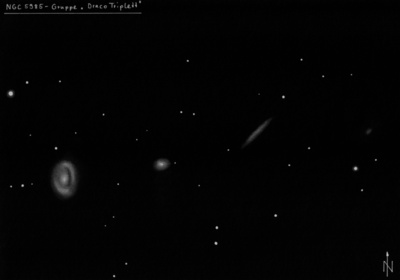
William Herschel discovered NGC 5985 = H II-766 on 25 May 1788 (sweep 843) and noted "pB, cL, iF, r." He measured an accurate position (CH's reduction) and discovered NGC 5982 (NGC 5981 as only noted as suspected).
George Johnstone Stoney, Lord Rosse's observing assistant, recorded "Suspect A to be a spiral, to be re-examined on a fine night." (6 May 1850). A week later (14 May) he wrote "Examined A; new spiral? Dark space round or on either side of Nucl seen at moments, also a dark line running along the south-following edge, splitting off a part of the neb, which had a bright knot to south, also some ill defined dark space at N end."
300/350mm - 13.1" (5/14/83): moderately bright, moderately large, diffuse halo N-S. Brightest of trio.
400/500mm - 17.5" (3/28/87): fairly bright, large, small bright core, mottled oval disc ~N-S. There is possibly a sharper light cut-off along the western side. Third and brightest of three with NGC 5982 7.5' WNW and NGC 5981 13.8' WNW.
600/800mm - 24" (7/6/13): bright, very large, oval 2:1 ~N-S, ~4'x2', broad concentration with a bright 40"x30" core. Spiral structure is evident in the uneven halo, with at least two long sweeping arms giving the impression of a stretched "S" and slightly darker gaps between the arms.
Notes by Steve Gottlieb